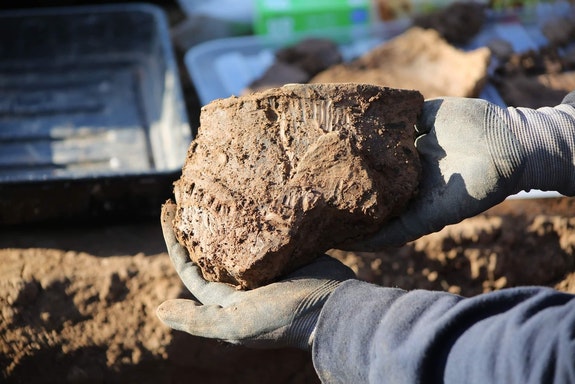Bronze Age Pot Discovered in Wales
An archaeological dig has uncovered what could be the earliest house found in Cardiff. Volunteers and archaeologists from the Caerau and Ely Rediscovering (CAER) Heritage Project, found a clay pot which could be about 3,000 years old.

The group were looking for the missing link between the late Iron Age and the early Roman period.
Co-director of the project Dr David Wyatt said what they found was “much more remarkable.”
The archaeologists said the roundhouse, located near Cardiff West Community High School, could provide the earliest clues on the origins of Cardiff.
Over 300 people have taken part in the dig, at Trelai Park, about half a mile away from the Caerau Hillfort, a heritage site of national significance.
Archaeologists and community members had previously discovered finds of Neolithic, Iron Age, Roman and medieval origins at the hillfort.
Experts believed the settlement dubbed “Trelai Enclosure” could provide the missing link between the late Iron Age and early Roman period, showing what happened to people once they had moved on from the hillfort.
‘Incredible development’

But, the roundhouse predates it, a clay pot discovered at the site has given the team a firmer indication of the time period the building can be traced to.
Dr Wyatt added that they believed the roundhouse could have been constructed in the mid to late Bronze Age, going back to between 1500 and 1100 BC.
“The enclosure definitely predates the hillfort, people were living here before the hillfort was built.
“It’s an incredible development and sheds light on the earliest inhabitants of Cardiff,” he added.
Project co-director Dr Oliver Davis said: “What we’ve found is completely unexpected and even more exciting.
“This enclosure could be providing us with the earliest clues on the origins of Cardiff, the pot that’s been found is beautifully decorated and preserved – it is extremely rare to find pottery of this quality.
“It’s also unusual to find a Bronze Age settlement in Wales – there are only one or two other Bronze Age sites in this country.”
‘Opportunity to learn’

Nearly 300 volunteers have participated in the dig so far, run by CAER, a partnership between Cardiff University, Action in Caerau and Ely (ACE), local schools, residents and heritage partners.
Archaeologist Tom Hicks and volunteers Charlie Adams both found and recovered the pot during the dig.
Mr Hicks said: This is a very well-preserved example of Bronze Age pottery, and a significant find for the archaeological record in the region.
“It’s a great opportunity for us to learn more about the lives of the people living on the sire around 3,000 years ago.”
He added that further scientific analysis may be able to tell what the pot was used for before it ended up in the enclosure ditch, and how or where the pot was made.
Headteacher at Cardiff West Community High School, Martin Hullard said: “We’re delighted to be involved in this exciting archaeological project, our students have loved learning about the history that’s just a stone’s throw away from their school.”
